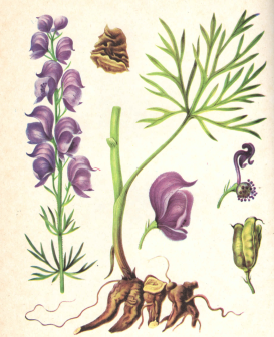Perennials that develop an herbaceous stem covered with alternate, rounded leaves, which are more or less deeply palmate-lobed. The inflorescence is a terminal raceme of large flowers. The flowers are irregular: the calyx is five-lobed, colored, and petal-like; the upper lobe is helmet-shaped. Beneath this «helmet» lies a reduced corolla transformed into two nectaries. The flowers have many stamens, and the ovary is superior (there is no spur, distinguishing it from Delphinium). The fruit is a dry aggregate of follicles. Blooming occurs in the second half of summer.
All species of the genus Aconitum contain alkaloids. In the «Flora,» 51 species are listed, divided into four sections:
1) Anthora (only two species)
2) Lycoctonum
3) Napellus
4) Catenatae.
The sections differ in flower color, the height of the flower’s helmet, the number of follicles, and especially in their root systems.
The root system is of two types. A small tuber-like conical root, black on the outside, develops 1–2 young daughter tuberous roots during summer, overwinters, and gives rise to a new plant in spring. By the end of the growing season, the old tuber either dies off along with the above-ground part or remains connected to the new root, forming a chain of several, sometimes 12–15, tubers. Species in these sections have 3–7 follicles and flowers with a low helmet. Yellow flowers belong to the Anthora section (non-toxic species); blue flowers, according to the «Flora,» belong to the Napellus and Catenatae sections, distinguishable by the number of tuberous roots: Napellus has 2–3 roots, while Catenatae forms a root chain.
However, due to the instability of this characteristic, which depends on plant age and growing conditions, V. Voroshilov has proposed uniting these two sections under the name Napellus. Plants in this section are the most toxic. Species in the Lycoctonum section have a different root system type, forming no tubers but instead developing numerous thin, cord-like roots fused into a flat, slightly twisted taproot. Flowers in this section have a high helmet and are yellow, lilac, or white, with always three follicles. These plants are mildly toxic.
In medicine, tuberous species with blue flowers are used: aconite, or wolf’s bane, Karakol (Aconitum karakolicum Rapes) and aconite, or wolf’s bane, Dzungarian (Aconitum soongoricum Stapf) (illustrated).
Tuberous roots, known as Tuber Aconiti, are harvested in autumn, and the herb (Herba Aconiti) is collected in summer.

Alkaloids are present in all parts of the plants; tubers of these species contain 0.18–3%, and the herb contains 0.2%, though the quantity depends on the vegetative phase. Spring shoots before flowering are the richest in alkaloids.
The alkaloids of aconites are divided into two groups:
1)aconitines, the most toxic, including methyllycaconitine.
2)atizines, which are less toxic.
The main alkaloid is aconitine. Additionally, Dzungarian aconite contains the alkaloid songorine and non-toxic aconitic acid. Extreme toxicity limits its application. Currently, only a tincture made from Dzungarian aconite herb is used, included in the preparation «Acofit,» recommended for radiculitis treatment.
